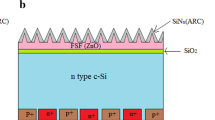Abstract
Interdigitated back contact-heterojunction (IBC-HJ) solar cells can have a conversion efficiency of over 25%. However, the front surface passivation and structure have a great influence on the properties of the IBC-HJ solar cell. In this paper, detailed numerical simulations have been performed to investigate the potential of front surface field (FSF) offered by stack of n-type doped and intrinsic amorphous silicon (a-Si) layers on the front surface of IBC-HJ solar cells. Simulations results clearly indicate that the electric field of FSF should be strong enough to repel minority carries and cumulate major carriers near the front surface. However, the over-strong electric field tends to drive electrons into a-Si layer, leading to severe recombination loss. The n-type doped amorphous silicon (n-a-Si) layer has been optimized in terms of doping level and thickness. The optimized intrinsic amorphous silicon (i-a-Si) layer should be as thin as possible with an energy band gap (E g) larger than 1.4 eV. In addition, the simulations concerning interface defects strongly suggest that FSF is essential when the front surface is not passivated perfectly. Without FSF, the IBC-HJ solar cells may become more sensitive to interface defect density.
Similar content being viewed by others
References
Saint-Cast P, Padilla M, Kimmerle A, Reichel C. An analytical model for interdigitated back contact-heterojunction solar cells. IEEE Journal of Photovoltaics, 2014, 4(1):114–121
World’s highest conversion efficiency of 26.33% achieved in a crystalline silion solar cell. 2016, http://www.nedo.go.jp/english/ news/AA5en_100109.html
Kerschaver E V, Beaucarne G. Back-contact solar cells: a review. Progress in Photovoltaics Research & Application, 2006, 14 (2):107–123
Aberle A G. Surface passivation of crystalline silicon solar cells: a review. Progress in Photovoltaics Research & Application, 2000, 8 (5):473–487
Peibst R, Harder N, Merkle A, Neubert T, Kirstein S, Schmidt J. High-efficiency RISE IBC-HJ solar cells: influence of rear side passivation on pn junction meander recombination. In: Process 28th Europe Photovoltaic Solar Energy Conference Exhibition. Paris, France, 2013
Taguchi M, Yano A, Tohoda S, Matsuyama K, Nakamura Y, Nishiwaki T. Record efficiency HIT solar cell on thin silicon wafer. IEEE Journal of Photovoltaics, 2014, 4(1):96–99
Van Sark W, Korte L, Raco F. Physics and Technology Amorphous-Crystalline Heterostrcutre Silicon Solar Cells. Berlin: Springer-Verlag Berlin and Heidelberg GmbH & Co. KG, 2013
Kanevce A, Metzger WK. Role of amorphous silicon and tunneling in heterojunction with intrinsic thin layer (HIT) solar cells. Journal of Applied Physics. 2009, 105(9): 094507–094507-7
Shockley W, Read WT. Statistics of the recombinations of holes and electrons. Physical Review, 1952, 87(5):835–842
Hall R N. Electron-hole recombination in germanium. Physical Review, 1952, 87(2):387
Fossum J G, Lee D S. A physical model for the dependence of carrier lifetime on doping density in nondegenerate silicon. Solid- State Electronics, 1982, 25(8): 741–747
Dziewior J, Schmid W. Auger coefficients for highly doped and highly excited silicon. Applied Physics Letters, 1977, 31(5): 346–348
Slotboom J W, Graaff H C D. Measurements of bandgap narrowing in Si bipolar transistors. Solid-State Electronics,1976, 19(10): 857–862
Wagner J, Del Alamo J A. Band-gap narrowing in heavily doped silicon: acomparison of optical and electrical data. Journal of Applied Physics, 1988, 63(2): 425–429
Tsunomura Y, Yoshimine Y, Taguchi M, Baba T, Kinoshita T, Kanno H. Twenty-two percent efficiency HIT solar cell. Solar Energy Materials & Solar Cells, 2009, 93(6–7):670–673
Cody G, Tiedje T, Abeles B, Brooks B, Goldstein Y. Disorder and the optical-absorption edge of hydrogenated amorphous silicon. Le Journal De Physique Colloques, 1981, 92(20): 1480–1483
Abdulraheem Y, Gordon I, Bearda T, Meddeb H, Poortmans J. Optical bandgap of ultra-thin amorphous silicon films deposited on crystalline silicon by PECVD. AIP Advances, 2014, 4:057122
Fahrner W R. Amorphous Silicon/Crystalline Silicon Heterojunction Solar Cells. Berlin: Springer Berlin Heidelberg, 2013, 90(12): G1117–G1121
Haase F, Eidelloth S, Horbelt R, Bothe K, Rojas E G, Brendel R. Loss analysis of back-contact back-junction thin-film monocrystalline silicon solar cells. Journal of Applied Physics, 2011, 110 (12):002874–002877
Author information
Authors and Affiliations
Corresponding author
Rights and permissions
About this article
Cite this article
Jia, R., Tao, K., Li, Q. et al. Influence of using amorphous silicon stack as front heterojunction structure on performance of interdigitated back contact-heterojunction solar cell (IBC-HJ). Front. Energy 11, 96–104 (2017). https://doi.org/10.1007/s11708-016-0434-6
Received:
Accepted:
Published:
Issue Date:
DOI: https://doi.org/10.1007/s11708-016-0434-6




